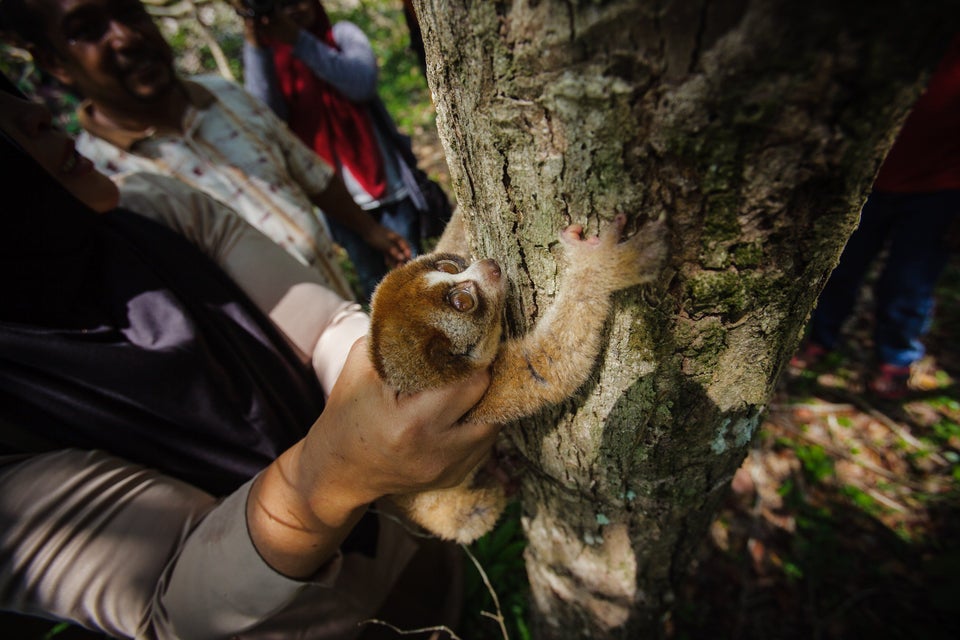A new short film explores the disturbing reality behind the “cute” slow loris videos that have proliferated online over the past few years.
The small, huge-eyed primates may look adorable being tickled, getting brushed or clutching tiny umbrellas, but they're actually suffering, according to the film, which was posted online last week by U.K.-based International Animal Rescue. The video is part of the animal welfare nonprofit’s “Tickling is Torture” campaign, which seeks to end the illegal trade in slow lorises as pets.
The group launched the project in response to a video of a “pole-dancing” slow loris that appeared online in March, IAR marketing executive Phily Kennington told HuffPost.
The first loris video to go viral, posted online in 2009, shows a female named Sonya being tickled while she lifts her arms over her head. Sonya’s owner calls her “the tickle lover.”
“Before these ‘cute’ videos went viral, not many people knew what a slow loris was. When people did start to learn about this amazing animal, it was for all the wrong reasons,” Kennington said.
The IAR, which runs a slow loris rehabilitation center in Indonesia, says that a loris raising up its arms is a sign of distress. Lorises secrete venom from a gland inside the elbow. When they feel threatened, the IAR site explains, they lift their arms to mix the venom with saliva before biting the threat.
Additionally, the bright light present in videos of Sonya and other lorises is uncomfortable for the nocturnal animals.
The suffering of slow lorises in the pet trade begins long before they reach a person's home, however.
Slow lorises sold as pets have typically been taken illegally from the wild in Southeast Asia. The illegal pet trade is one of the major threats to the wild population, which is also at risk due to habitat loss and poaching for traditional medicines. All eight species of slow lorises are considered “threatened” and the Javan slow loris is one of the 25 most endangered primates worldwide, according to "Tickled to Death: Analysing Public Perceptions of ‘Cute’ Videos of Threatened Species," a 2013 paper available through the Public Library of Science.
What a loris experiences after capture “is so horrific it cannot be imagined,” writes Anna Nekaris, professor in anthropology and primate conservation at the U.K.'s Oxford Brookes University and lead author of the “Tickled to Death" paper. She explains on her website:
[Slow lorises are] shoved into plastic crates and bags; their teeth are clipped out with crude mechanisms with no anaesthesia, no aftercare, no medicine and most die; multiple animals are transported in crates where they wound each other with their venomous bites; market conditions are inhumane, boiling hot, and cruel, with no proper food fed to the animals.
Large percentages of captured slow lorises die due to overcrowded, stressful conditions during transportation, according to the IAR. “Tickled to Death” cites several examples of officials confiscating lorises in such ill health that they died shortly afterward. In 1993, 80 percent of 102 lorises confiscated at a Taiwanese airport died during transport to a zoo. Out of 180 lorises brought to the IAR rehab center in Indonesia between 2008 and 2011, 51 died “despite intensive veterinary care.” The paper notes that these statistics do not take into account the lorises that died prior to confiscation.
Additionally, the majority of slow lorises sold as pets have their back teeth clipped out to prevent their venomous bites. This painful process not only “often” kills the animals via blood loss or infection, but also prevents rescued lorises from being released back into the wild, the paper notes.
Nekaris urges the public to “leave loris in the forest.” She writes on her website that even well-meaning slow loris owners typically have no idea how to properly care for them. As pets, they suffer from obesity, diabetes and rotting teeth due to improper diet, Nekaris writes, and the social animals often live out their lives “in loneliness.” She urges those who already have pet lorises to turn them over to a rescue center or zoo.
Slow loris advocates also say it’s important to not like or share videos of slow lorises kept as pets.
“The slow loris is now in serious danger of extinction and the greatest threat to its survival is the illegal trade in wildlife,” Kennington said. “The popularity of slow loris videos has led to an increase in the number of people wanting to have a slow loris as a pet."
Learn more about the IAR’s campaign here.
This story has been updated with comments from IAR executive Phily Kennington.
![]() Contact The Author
Contact The Author

